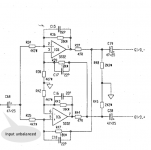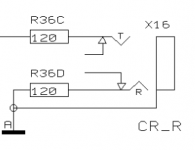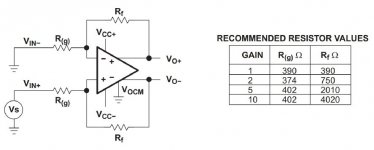Not a DIY guy, so if this is do-able I’ll be getting this done bespoke.
Asking the experts here for info on feasabilty etc.
Thanks. 🙂
Meridian 557 power amp, RCA and XLR inputs.
By all accounts balanced from Premo is the way to go with this amp, and used it this way with my last preamp, which had balanced outputs.
Amazing synergy with my latest Densen DM20 preamp (RCA unbalanced output only) so not looking to change preamps just to enable the Balanced connection...
but...
Had the thought, is it possible and how do-able is it to get work done on the Densen to enable an XLR balanced output?
Hoping for some input on this thanks, as I said just a first step to see what’s possible in this situation.
I don’t think an RCA to XLR cable would give “true” balanced connection, would it?
Pro Audio DI boxes an adoption, I s’pose, but much prefer as “direct from Pre-Amp” as possible, hence the DIY route.
Thank you.
Asking the experts here for info on feasabilty etc.
Thanks. 🙂
Meridian 557 power amp, RCA and XLR inputs.
By all accounts balanced from Premo is the way to go with this amp, and used it this way with my last preamp, which had balanced outputs.
Amazing synergy with my latest Densen DM20 preamp (RCA unbalanced output only) so not looking to change preamps just to enable the Balanced connection...
but...
Had the thought, is it possible and how do-able is it to get work done on the Densen to enable an XLR balanced output?
Hoping for some input on this thanks, as I said just a first step to see what’s possible in this situation.
I don’t think an RCA to XLR cable would give “true” balanced connection, would it?
Pro Audio DI boxes an adoption, I s’pose, but much prefer as “direct from Pre-Amp” as possible, hence the DIY route.
Thank you.
Last edited:
is it possible and how do-able is it to get work done on the Densen to enable an XLR balanced output?
These may help. First one looks better.
NE5532 Unbalanced to Balance Converter Board Match Differential Input Amplifier | eBay
Unbalanced to Balanced Dual Channel Converter Bare PCB Board For Pre-amplifier | eBay
Last edited:
Making a (basic) balanced output out of an unbalanced one is trivial, you just need to know its output impedance:

(Borrowed from a Behringer UB802. R36D may just as well be inside an external adapter. If you need XLR, substitute T --> 2, R --> 3, S --> 1.)
This is what they call an impedance-balanced output. For best results, impedances need to be mirrored as precisely as possible, so if e.g. there is a coupling capacitor you'd want to replicate that as well.
There are further advantages to be gained from more advanced circuits, which is going to depend on the balanced input stage.
(Borrowed from a Behringer UB802. R36D may just as well be inside an external adapter. If you need XLR, substitute T --> 2, R --> 3, S --> 1.)
This is what they call an impedance-balanced output. For best results, impedances need to be mirrored as precisely as possible, so if e.g. there is a coupling capacitor you'd want to replicate that as well.
There are further advantages to be gained from more advanced circuits, which is going to depend on the balanced input stage.
Attachments
Active volume control with balanced output using 2 op-amps
Here you will find various circuits of floating output stage :
Control level with quasi-floating output using 4 op-amps
Here you will find various circuits of floating output stage :
Control level with quasi-floating output using 4 op-amps
That is definately NOT balanced.Making a (basic) balanced output out of an unbalanced one is trivial, you just need to know its output impedance:
(Borrowed from a Behringer UB802. R36D may just as well be inside an external adapter. If you need XLR, substitute T --> 2, R --> 3, S --> 1.)
This is what they call an impedance-balanced output. For best results, impedances need to be mirrored as precisely as possible, so if e.g. there is a coupling capacitor you'd want to replicate that as well.
There are further advantages to be gained from more advanced circuits, which is going to depend on the balanced input stage.
It is balanced and extremely common in pro audio. Sometimes called "impedance balanced" (as already said).
For reference: Q. How is impedance balancing audio different from normal balancing?
For reference: Q. How is impedance balancing audio different from normal balancing?
Last edited:
This question comes up from time to time. Perhaps, the first thing to understand is that there is a difference between an balanced (impedance) interconnection and differential (signal) drive. Balanced interconnection is for the purpose of rejecting common-mode (so called, ground-loop) noise. Differential signal drive is not necessary to implement common-mode noise rejection. These can be seperate.
That said, the most simple means (and lowest cost) of adding a still TRUE balanced output to an unbalanced output circuit is depicted in Jensen Transformers app. note AN003, figure 2.4.
https://www.jensen-transformers.com/wp-content/uploads/2014/08/an003.pdf
That said, the most simple means (and lowest cost) of adding a still TRUE balanced output to an unbalanced output circuit is depicted in Jensen Transformers app. note AN003, figure 2.4.
https://www.jensen-transformers.com/wp-content/uploads/2014/08/an003.pdf
One other way would be to use a pair of Jensen transformers, something like the JT-11-FLCF (cheapest option) or preferably the JT-11-DMCF. As transformers go, they're pretty darn good. I'm not going to call them perfectly transparent, but I definitely have to try pretty hard to notice even the JT-11-FLCF.
Galvanic isolation is a bonus, though it's not as big a deal these days. If you're like me and you have some old amps (or in my case, active monitors) that sound fantastic but are essentially a ground loop in a box, it can be really nice.
Galvanic isolation is a bonus, though it's not as big a deal these days. If you're like me and you have some old amps (or in my case, active monitors) that sound fantastic but are essentially a ground loop in a box, it can be really nice.
- Home
- Amplifiers
- Solid State
- Is it possible to convert a Preamps output to poweramp from unbalanced to balanced?


